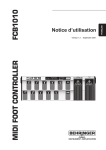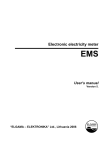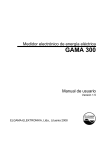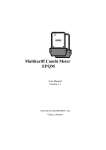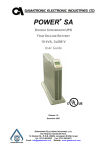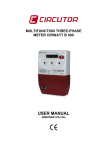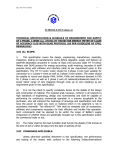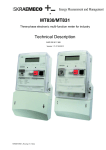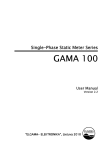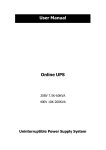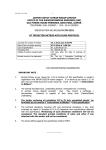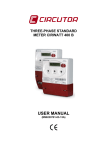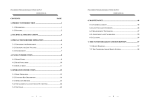Download Static electricity meter GAMA 300 User manual - Elgama
Transcript
Static electricity meter GAMA 300 User manual Version 2.2 “ELGAMA – ELEKTRONIKA”, Lithuania 2010 “ELGAMA-ELEKTRONIKA” Static electricity meter GAMA 300 USER MANUAL "ELGAMA-ELEKTRONIKA" 2 Visorių str. LT-08300 Vilnius Ph.: +370 5 2375000 Fax: +370 5 2375020 E-mail: [email protected] REVISION HISTORY Version 1.0 1.1 1.2 2.0 2.1 2.2 Date 2008 05 09 2008 06 30 2008 08 08 2009 05 22 2009 09 02 2010 01 05 Comments First release Few corrections of user manual structure made Reference to standard EN-50470-1 was added, corrections GD2 construction added, some chapters added Corrections Information updated STATIC ELECTRICITY METER GAMA 300. USER MANUAL Contents Contents ..................................................................................................................................................................5 List of tables.............................................................................................................................................................6 List of figures ...........................................................................................................................................................6 About this document ................................................................................................................................................8 1 Safety ..............................................................................................................................................................9 1.1 Safety requirements ...............................................................................................................................9 1.2 Transportation and storage rules ...........................................................................................................9 1.3 Prevention and elimination of malfunctions............................................................................................9 1.3.1 Exterior inspection .............................................................................................................................9 1.3.2 Inspection of connection and parameterisation constants.................................................................9 1.3.3 Procedure of returning to manufacturer ...........................................................................................10 1.3.4 Proper disposal of product ...............................................................................................................10 2 Designation ...................................................................................................................................................11 3 Meter modifications .......................................................................................................................................12 3.1 Modifications ........................................................................................................................................12 3.2 Technical specifications .......................................................................................................................13 4 Functional possibilities ..................................................................................................................................14 4.1 Current, voltage, frequency ..................................................................................................................14 4.2 Energy measurement, instantaneous values, load profiles .................................................................14 4.3 Sealed button functions........................................................................................................................15 4.4 Backup power source...........................................................................................................................16 4.5 Communication, inputs/outputs ............................................................................................................17 4.6 Auxiliary electrical interface..................................................................................................................18 4.7 R- internal bi-stable mains relay...........................................................................................................18 4.8 LCD options..........................................................................................................................................18 5 Construction ..................................................................................................................................................20 5.1 Case .....................................................................................................................................................20 5.2 Operation principle ...............................................................................................................................24 5.2.1 Measurement module ......................................................................................................................24 5.2.2 Signal conversion.............................................................................................................................24 5.2.3 Micro-controller ................................................................................................................................24 5.2.4 Non-volatile memory ........................................................................................................................24 5.3 Indicator................................................................................................................................................24 5.3.1 Mechanical register ..........................................................................................................................24 5.3.2 Liquid crystal display........................................................................................................................24 5.4 Internal clock ........................................................................................................................................28 5.5 Sliding voltage links (direct connected meters)....................................................................................28 6 Communication .............................................................................................................................................30 6.1 Optical communication interface ..........................................................................................................30 6.2 Electrical interface ................................................................................................................................30 6.2.1 Radio module ...................................................................................................................................30 6.3 Controller MCL 5.0 with internal GSM/GPRS modem .........................................................................30 6.4 DLC interface .......................................................................................................................................30 6.5 Outputs/Inputs ......................................................................................................................................32 6.5.1 Optical test outputs (red LEDs)........................................................................................................32 6.5.2 S0 outputs ........................................................................................................................................32 6.5.3 Tariff switch input .............................................................................................................................32 6.5.4 Relay output .....................................................................................................................................32 6.6 Internal mains relay ..............................................................................................................................32 6.7 Power supply........................................................................................................................................33 6.8 Push buttons ........................................................................................................................................33 6.8.1 Scroll push button ............................................................................................................................33 7 Tariff module .................................................................................................................................................34 7.1 Tariff program .......................................................................................................................................34 7.1.1 Day tariff programs ..........................................................................................................................34 7.1.2 Week tariff program .........................................................................................................................34 7.1.3 Tariff seasons...................................................................................................................................35 7.2 List of special days ...............................................................................................................................35 7.3 Tariff registers ......................................................................................................................................35 7.4 Load profiles .........................................................................................................................................36 7.5 “Emergency” tariff.................................................................................................................................37 5 8 Data reading................................................................................................................................................. 38 8.1 Manual data scrolling on the LCD (G3A/GD2) .................................................................................... 38 8.1.1 Scrolling through menu of parameters............................................................................................ 39 8.1.2 Scrolling of billing data .................................................................................................................... 43 8.1.3 Scrolling of instantaneous values ................................................................................................... 45 8.2 Automatic data scrolling ...................................................................................................................... 45 8.2.1 Data indication in “economy” liquid crystal display ......................................................................... 45 8.3 Indication of abnormal states on LCD ................................................................................................. 46 8.3.1 Internal meter errors........................................................................................................................ 47 8.4 Indication of normal and abnormal meter states (G3T)....................................................................... 47 8.5 Data reading via communication interfaces ........................................................................................ 47 9 Parameterisation .......................................................................................................................................... 48 10 Data protection............................................................................................................................................. 49 10.1 Physical protection .............................................................................................................................. 49 10.2 Software protection ............................................................................................................................. 49 10.2.1 Password .................................................................................................................................... 49 10.2.2 User’s identifiers ......................................................................................................................... 49 10.2.3 Blocking of optical communication interface............................................................................... 49 10.2.4 Event register.............................................................................................................................. 49 10.2.5 Other means of prevention ......................................................................................................... 50 11 Installation .................................................................................................................................................... 51 Annex A. Dimensions of the meter ....................................................................................................................... 53 Annex B. Screw torques used in GAMA 300 meters............................................................................................ 54 List of tables Table 3-1 GAMA 300 meter modifications............................................................................................................ 12 Table 3-2 Technical specifications........................................................................................................................ 13 Table 4-1 Ordering code....................................................................................................................................... 14 Table 4-2 Possible code choices for Reference/Rated currents, reference voltage and reference frequency .... 14 Table 4-3 Possible code choices for energy measurement, instantaneous values and load profiles.................. 15 Table 4-4 Possible code choices for sealed button functions .............................................................................. 15 Table 4-5 Possible code choices for backup power source ................................................................................. 16 Table 4-6 Possible code choices for communications, inputs/outputs ................................................................. 17 Table 4-7 Communications, inputs/outputs choices for different meter constructions ......................................... 18 Table 4-8 Possible code choices for auxiliary electrical interface ........................................................................ 18 Table 4-9 Possible code choices for LCD backlight options ................................................................................ 18 Table 4-10 Possible code choices for LCD options.............................................................................................. 19 Table 5-1 Explanation of Figure 5-4 - Figure 5-6.................................................................................................. 23 Table 5-2 Possible clock adjustments .................................................................................................................. 28 Table 6-1 DLC interface technical characteristics ................................................................................................ 31 Table 6-2 Data that can be read via DLC interface .............................................................................................. 31 Table 7-1 Example of day tariff programs ............................................................................................................ 34 Table 7-2 Example of week profiles ..................................................................................................................... 34 Table 7-3 List of tariff seasons.............................................................................................................................. 35 Table 7-4 Permanent Special days list ................................................................................................................. 35 Table 7-5 Leap-special-days list ........................................................................................................................... 35 Table 7-6 Data amounts saved............................................................................................................................. 35 Table 7-7 Load profile differences ........................................................................................................................ 36 Table 7-8 Storage interval of load profiles (days)................................................................................................. 36 Table 8-1 List of ways to access meter data ........................................................................................................ 38 Table 8-2 Meanings of digits in meter configuration............................................................................................. 39 Table 8-3 Description of relations of maximum demand tariffs and energy tariffs ............................................... 43 Table 8-4 Instantaneous values and codes.......................................................................................................... 45 Table 8-5 Description of G3T meter signaling LEDs ............................................................................................ 47 Table 9-1 Parameters that rise data reset ............................................................................................................ 48 Table B-0-1 Screw torques used in GAMA 300 meters........................................................................................ 54 List of figures Figure 4-1 View of changeable battery in top right corner of G3A meter ............................................................. 16 Figure 5-1 G3T meter exterior .............................................................................................................................. 20 Figure 5-2 G3E meter exterior .............................................................................................................................. 20 6 Figure 5-3 G3A/GD2 meter exterior ......................................................................................................................21 Figure 5-4 G3T meter nameplate ..........................................................................................................................21 Figure 5-5 G3E meter nameplate ..........................................................................................................................22 Figure 5-6 G3A meter nameplate ..........................................................................................................................22 Figure 5-7 GD2 meter nameplate..........................................................................................................................23 Figure 5-9 Segments and fields of default G3E liquid crystal indicator .................................................................25 Figure 5-8 Segments and fields of optional G3E liquid crystal indicator ...............................................................25 Figure 5-10 Segments and fields of G3A liquid crystal indicator...........................................................................26 Figure 5-11 Segments and fields of GD2 liquid crystal indicator...........................................................................27 Figure 5-12 Sliding voltage links (connected) .......................................................................................................29 Figure 8-1 Main data scrolling cycle ......................................................................................................................39 Figure 8-2 Scrolling cycle of parameters ...............................................................................................................40 Figure 8-3 Scrolling diagram of relay program ......................................................................................................41 Figure 8-4 Diagram of scrolling of tariff seasons and week profiles data..............................................................41 Figure 8-5 Diagram of scrolling through day profiles data.....................................................................................42 Figure 8-6 Diagram of scrolling through cycle of special days ..............................................................................43 Figure 8-7 Diagram of scrolling through billing data..............................................................................................44 Figure 8-8 Examples of data indication .................................................................................................................44 Figure 11-1 Direct connection (4 wires).................................................................................................................51 Figure 11-2 Connection by current transformers (4 wires)....................................................................................51 Figure 11-3 Connection by current and voltage transformers (4 wires) ................................................................51 Figure 11-4 Connection by current and voltage transformers (3 wires) ................................................................51 Figure 11-5 Connection by current and voltage transformers (4 wire meter; 3 wire network) ..............................51 Figure 11-6 Location of terminals and auxiliary contacts ......................................................................................52 Figure 11-7 Direct connected meter terminal block...............................................................................................52 Figure 11-8 Transformer connected meter terminal block ....................................................................................52 Figure A-0-1 Dimensions of the meter and fixing holes ........................................................................................53 Figure B-0-1 Screws used in direct connected GAMA 300 meters .......................................................................54 Figure B-0-2 Screws used in transformer connected GAMA 300 meters .............................................................55 7 About this document This User Manual presents a description and exploitation instruction for static electricity meters GAMA 300. Please read this instruction prior to the use of the meters. The manufacturer does not give any guaranty in case meters are damaged during the exploitation that contravenes with the instructions and requirements of safety stated in the manual and meter passport. The manufacturer is not responsible for the loss in case the meter is parameterised without accordance with the instructions and recommendations presented in the software description as well as with tariff order defined by the State. It does not carry the responsibility for the unprofessional acts of responsible persons in case of full or partial loss of billing data. User manual presents the description of all possible characteristics, functions and auxiliary outputs of electricity meter. A concrete meter may not comply with all characteristics introduced in this manual; however, meter passport defines a precise meter configuration, possibilities and auxiliary outputs as well as a concrete connection scheme. The manufacturer has a right to change the information presented in this manual without the forehand warning. In addition, any copying, transmission and publication of full or partial meter documentation is forbidden without a written ELGAMA-ELEKTRONIKA permission 1 Safety 1.1 Safety requirements 1. Installing, uninstalling, parameterisation and verification can be performed only by authorized organizations that have technicians with necessary qualifications. Only qualified persons can fulfil meter-assembling works. 2. Meter’s connection or disconnection from network should be done when voltage in the network is turned off. A protection from accidental network voltage connection must be established. 3. No accessories can be hung on a meter, it is forbidden to hit or strike meter’s case. 4. Precautions must be taken in battery changing procedure: 1) meter has to be disconnected from electricity network, a protection from accidental network voltage connection must be assured; 2) use pincers or similar instruments to change battery (connection/disconnection of a plug). 1.2 Transportation and storage rules 1. Prior to the usage meter must be kept in a closed room, where the temperature ranges from 5°C to 40°C and average area humidity is up to 80% when temperature being 25°C, in a transportation packing. The room must be without harmful gas or steam. Meter must be kept and exploited in premises protected from dust, aggressive vapours and gas. 2. Unpacked meters can be kept only in repair workshop. Meter can be loaded not more than five rows on each other and separators must be used. The temperature must range from 10°C to 35°C, average area humidity must not exceed 80% when temperature being 25°C. 3. During wintertime meters must be kept in a heated room for 6 hours or more, before they are used. 4. Meters are to be transported only in closed vehicles (carriage, container, hold). Shake acceleration is to be up to 30m/s², 80-120 strikes per minute. The temperature must range from -40°C to +70°C, average area humidity mu st not exceed 98% when temperature being 35°C. 1.3 Prevention and elimination of malfunctions If suspected that meter works improperly, the following actions should be performed: 1.3.1 Exterior inspection Before starting voltage supply to the meter make sure its case has no mechanical damages, there are no signs of overheating, all wires are properly connected. Do not plug a meter into network if it is mechanically damaged. This can cause staff injuries and destroy meter as well as other equipment! Before switching on network voltage, it is necessary to check if sliding voltage link is connected (see chapter Sliding voltage links (direct connected meters)). 1.3.2 Inspection of connection and parameterisation constants After plugging a meter into electric network check whether date and time are correct, whether meter shows right energy direction, valid tariff time zone, calendar and tariff seasons. 1. If meter shows wrong date and time, contact a representative from the organization in charge of the meter installation. 2. If LCD indicator shows a warning note ‘Er’, the meter should be uninstalled and passed for repair works. 3. If energy direction is wrong, check if inputs are connected properly to terminal block. 4. If meter calendar season, season time name or valid tariff time zone does not correspond to real situation, meter’s parameterisation data has to be checked and errors has to be corrected by repeated meter’s parameterisation. 1.3.3 Procedure of returning to manufacturer In case malfunctions cannot be eliminated on the spot, the meter should be returned to the manufacturer for repair or replacement. Meters on their return to manufacturer must have their Passport with notices of organization in charge of their exploitation and short description of meter’s malfunctioning. 1.3.4 Proper disposal of product This sign indicates, that this product cannot be thrown out with any other waste, when its validity period is over if this sign is on the product or it is included in product’s description. In order to prohibit possible harm for environment and human health because of uncontrolled waste elimination, please separate this product from other forms of waste, and if it is possible use this product or its parts repeatedly in recycling process. Home users can contact product manufacturer or local administration for information about product utilization and recycling without any harm to the environment. Enterprises must contact their own providers to revise product’s validity terms and conditions stated in purchase agreements. This product cannot be thrown out with any other waste of different purpose. 2 Designation The static meter GAMA 300 is designated for measurement of active or active and reactive electrical energy in three-phase 4-wire or 3-wire alternate current networks and also may be used in single-phase alternate current networks. Depending on modification the meters GAMA 300 can be used for direct connection or through current or/and voltage transformers. Optionally GAMA 300 meters can register maximum demand on daily and monthly bases, measure instantaneous values, as well as record load profile and event log. Meters can be either single-rate or multi-rate. The rates can be controlled externally or internally (by internal real-time clock). GAMA 300 meters have S0 output(s) and optionally can have optical and electrical communication interfaces for local and remote data transmission. Meters GAMA 300 conforms to the following requirements of directives and standards: - Directive 2004/22/EC of the European Parliament and of the Council of 31 March 2004 on measuring instruments; - Directive 2004/108/EC of the European Parliament and of the Council of 15 December 2004 on the approximation of the laws of the Member States relating to electromagnetic compatibility and repealing Directive 89/336/EEC; - EN50470-3:2006 “Electricity metering equipment (a.c.) – Static meters for active energy (class indexes A, B and C)”; - EN50470-1:2006 “Electricity metering equipment (a.c.) – General requirements, tests and test conditions – Metering equipment (class indexes A, B and C)”; - IEC 62053-21:2003 “Electricity metering equipment (a.c.) – Static meters for active energy (classes 1 and 2)”; - IEC 62053-22:2003 “Electricity metering equipment (a.c.) – Static meters for active energy (classes 0,5s and 0,2s)”; - IEC 62053-23:2003 “Electricity metering equipment (a.c.) – Static meters for reactive energy (classes 2 and 3)”; - IEC 62052-11:2003 “Electricity metering equipment (a.c.) – General requirements, tests and test conditions”; - IEC 62054-21:2004 “Electricity metering equipment (a.c.) – Tariff and load control. Part 21: Particular requirements for time switches” Note: Tables and Figures of this User manual present measurement values and pulse outputs in all possible energy and power directions (+A, -A, +R, -R, +P, -P, +Q, -Q). Actual number of measured values and pulse outputs of certain meter modification are indicated in meter passport. 11 3 Meter modifications 3.1 Modifications Meter GAMA 300 has the following main modifications: • G3T - Single-tariff meters (measures active energy) • G3E - Single-tariff or double-tariff meters with external tariff-switching (measures active energy) • G3A - Multi-tariff meters (measures active and reactive energy) • GD2 – a G3A modification with internal DLC modem (data transmission over power lines) Detailed explanation of meter modifications is presented in Table 3-1. Table 3-1 GAMA 300 meter modifications Type explanation example: XXX. G3A. Construction G3T (mechanical register, 1 tariff, active energy) G3T G3E (LCD, 1 or 2 tariffs, active energy) G3E G3A (LCD, multi-tariff, active energy or active and reactive energy, max demand) G3A G3A with internal DLC modem (LCD, multi-tariff, active energy or active and reactive energy, max demand) GD2 X 1 Accuracy class A (EN-50470-3), 2.0 (IEC 62053-21) 0 B (EN-50470-3), 1.0 (IEC 62053-21) 1 C (EN-50470-3), 0.5s (IEC 62053-22) (only for G3A and GD2 transformer connected) 5 X 4 Measurement circuits 2 elements, 3 wire (only for G3A transformer connected) 3 3 elements, 4 wire 4 Iref/Imax, In/Imax 1:8 1:10 1:12 1:16 1:20 1:1,25 1:2 1:6 X 1 0 1 2 3 4 6 7 8 Example: G3A.141 is G3A construction meter that conform the requirements of accuracy class B and 1.0. Meter is designated for measurement of energy in 4 wire alternate current networks it has 3 measurement elements. It is direct connected meter with maximum current up to 100 A. Ratio of reference current and maximum current is 1:10. 12 3.2 Technical specifications Table 3-2 Technical specifications Accuracy class: Active energy measurement Active energy measurement (only for transformer connected G3A/GD2) Reactive energy measurement Reference voltage Un, V: Operating voltage range, % from Un: Rated In (maximum Imax) and Reference Iref (maximum Imax) current, A: Sensitivity, % from In /Iref: Reference frequency, Hz: Power consumption, VA: In voltage circuits B (EN 50470-3), 1.0(IEC 62053-21) C (EN 50470-3), 0.5s(IEC 62053-22) 2.0 (IEC 62053-23) See Table 4-2 -20... +15 See Table 3-1 and Table 4-2 0,4 (direct connected) B class 0,2 (transformer connected) B class 0,1 (transformer connected) C class 50 <1.0VA (<0.5 W) (G3A) <2.3VA (<0.8 W) (with auxiliary electrical interface) (G3A) <14 (<2,8 W) (GD2 (in phase L1)) <9 (< 0,9 W) (GD2 (in phases L2, L3)) <1.4VA (<0.7 W) (G3E) In current circuits Meter constant, imp/kWh, imp/kVArh: Internal clock (IEC 62054-21): Tariff module functions: S0 outputs (IEC 62053-31): Error Backup power supply for clock Operation duration using only backup power supply Number of energy tariffs “Emergency” tariff Number of maximum demand tariffs Data storage duration when voltage disconnected Number Output constant, imp/kWh (imp/kVArh) Pulse duration, ms Relay output: Maximum commutation voltage, V Maximum commutation current, mA Internal mains relay: Communication interfaces: Isolation: Maximum commutation current, A Maximum commutation power, VA No. of life switching operations Optical interface Electrical interface – CS (20mA current loop) Auxiliary electrical interface – CS, RS485, RS232 Radio M-Bus DLC Pulse voltage tests (IEC 60060-1) Alternating voltage tests Protection against dust and water Temperature range: <1VA (<0.51 W) (G3T) < 0,5 (transformer connected) < 0,05 (direct connected) 1…19999 (direct connected) 1…60000 (transformer connected) < 0,5 s/24 h (T=23°C), < 0,1 s/°C/24 h Li-ion battery > 10 years Programmable (1 … 4) Programmable Programmable (1 … 4) >20 years 1…4 1…19999 (direct connected) 1…60000 (transformer connected) 30 Programmable 250 120 Bi-stable 100 25000 6 10 IEC 62056-21, DLMS IEC 62056-31 or IEC 62056-21 IEC 62056-31, DLMS IEC 62056-31 EN 13757-2; EN 13757-3; OFDM, CENELEC and FCC, DLMS 6 kV 4 kV IP 51 (default) IP 53 (option) Operation: For meters with battery and for meters without power backup source - 40 … +70°C (3K7) For meters with supercapacitor - 25 … +70°C Storage, transportation: - 40 … +70°C - 40 … -25°C LCD may not function * Mass, kg: Dimensions, mm < 1,4 260x175x80 *- if LCD stopped working properly in temperature lower than -25°C, it will recover when temperature will become higher than -25°C 13 4 Functional possibilities Meters GAMA 300 can have different functional possibilities. All these possibilities are described below. Table 4-1 Ordering code Code: X X X. No. Rated / Reference current 1 See chapter 4.1 Reference voltage See chapter 4.1 Reference frequency See chapter 4.1 F - additional programmable Functions (only G3A, GD2) 2 See chapter 4.2 B - sealed Button functions (only G3A, GD2) 3 See chapter 4.3 P - backup Power source (only G3A, GD2) 4 See chapter 4.4 C - Communication, I/O 5 See chapter 4.5 A - Auxiliary electrical interface (only G3A) 6 See chapter 4.6 R- internal bi-stable mains relay (only G3A,GD2) 7 See chapter 4.7 L - LCD options 8 See chapter 4.8 FXX. BX. PX. CXXX. AX. RX. LX. 4.1 Current, voltage, frequency Depending on the choice GAMA 300 meters may differ in rated/reference currents, reference voltages and reference frequencies. Choices of reference/rated current, reference voltage and reference frequency is denoted with the first three digits in ordering code. All possible choices are listed in Table 4-2. Table 4-2 Possible code choices for Reference/Rated currents, reference voltage and reference frequency Code: No. Rated / Reference current 1 1A 5A 10A Reference voltage 3x57,7/100V; 3x63,5/110V; 3x69,2/120V; (only transformer connected meters); 3x100V; 3x110V; 3x120V 3x120/208V; 3x127/220V; 3x220V; 3x230V; 3x220/380V; 3x230/400V; 3x240/415V; 3x57,7/100...230/400V Reference frequency 50 Hz X X X. 1 2 3 1 2 3 4 0 4.2 Energy measurement, instantaneous values, load profiles Depending on the choice GAMA 300 meters may measure active or active and reactive energy, instantaneous values and record load profile. Choices of energy measurement and programmable functions are denoted with letter “F” and two digits in ordering code. All possible choices are listed in Table 4-3. Energy measurement choices, instantaneous values and load profile choices are available only for G3A/GD2 meters. 14 Table 4-3 Possible code choices for energy measurement, instantaneous values and load profiles F - Energy measurement, instantaneous values, load profiles Code: FX No. Energy measurement 2 F1 Active energy (A) uni-direction F2 Active energy (A+, A-) bi-direction F3 Active uni-direction (A) and Reactive (R+, R-) import-export F4 Active bi-direction (A+, A-) and Reactive (R+, R-) import-export Programmable functions No additional functions Instantaneous values (A, V, kW, kVAr, cos ϕ, Hz each phase) Instantaneous values (A, V, kW, kVAr, cos ϕ, Hz each phase), load profile A Instantaneous values (A, V, kW, kVAr, cos ϕ, Hz each phase), load profile B Instantaneous values (A, V, kW, kVAr, cos ϕ, Hz each phase), load profile C Instantaneous values (A, V, kW, kVAr, cos ϕ, Hz each phase), instantaneous values in load profile, load profile E Instantaneous values (A, V, kW, kVAr, cos ϕ, Hz each phase), load profile D X. 0 1 2 3 4 5 6 In general, the available metering registers of energy and power (demand) depend on the meter configuration. The following configurations can be ordered: • F1 - Unidirectional active: energy |A| and demand |P|; • F2 - Bidirectional active: energy +A, -A and demand +P, -P; • F3 - Unidirectional active and bidirectional reactive: energy +A, +R, -R and demand +P, +Q, -Q; • F4 - Bidirectional active and bidirectional reactive: energy +A, -A, +R, -R and demand +P, -P, +Q, -Q; For more information about instantaneous values refer to chapter 8.1.3. For more information about load profiles refer to chapter 7.4. 4.3 Sealed button functions Depending on the choice GAMA 300 meters may have sealed button, which may perform one of the functions described below. Choices of sealed button functions are denoted with letter “B” and one digit in ordering code. All possible choices are listed in Table 4-4. Sealed button functions are available only for G3A/GD2 meters. Table 4-4 Possible code choices for sealed button functions B-sealed Button functions No. 3 B - sealed Button functions Without Billing period reset Communication unblock for parameterization Communication unblock for reading and parameterization Billing period reset and communication unblock for parameterization Billing period reset and communication unblock for reading and parameterization Code: BX. B1 B2 B3 B4 B5 Sealed button may have one of the following functions: • Communication unblock – meter blocks optical interface for parameterisation or parameterisation and reading until this button is pushed. In one hour after last communication session, optical interface blocks automatically again. • Billing period reset - reset signal triggers the storage of the billing data to the appropriate area of non-volatile memory and new billing period starts. Refer to ordering code to find out which function is implemented in the meter: • B1 – Sealed button performs a function of billing period reset. • B2 – Sealed button performs a function of communication unblock only for parameterisation 15 • • • B3 – Sealed button performs a function of communication unblock for both reading and parameterisation. B4 – Sealed button performs function of both billing period reset and communication unblock, but only for reading. Single push of a button initiates both actions at a time. B5 – Sealed button performs function of both billing period reset and communication unblock for reading and for parameterisation. Single push of a button initiates all actions at a time. 4.4 Backup power source Depending on the choice GAMA 300 meters may have different backup power sources. Choices of backup power source are denoted with letter “P” and one digit in ordering code. All possible choices are listed in Table 4-5. Table 4-5 Possible code choices for backup power source P - backup Power source No. 4 Without Supercapacitor Unchangeable battery Changeable battery Changeable battery and supercapacitor Unchangeable battery and supercapacitor Code: PX. P1 P2 P3 P4 P5 Refer to ordering code to find out which function is implemented in the meter: • P1 – Supercapacitor is mounted in meter as backup power source (G3A/GD2 only). • P2 – Directly mounted battery on PCB is used as backup power source (G3A/GD2 and G3E meters). • P3 – Changeable battery is mounted in meter as backup power source (G3A/GD2 only). • P4 – Both changeable battery and supercapacitor are mounted in meter as backup power sources (G3A/GD2 only). • P5 - Directly mounted battery and supercapacitor on PCB are used as backup power sources (G3A/GD2 only). Unchangeable battery is mounted on the top right corner of the meter PCB. Changeable battery is mounted on the top right corner of the meter under the sealable battery cover and under silicone protection. Battery cover with sealing option is available on the top right corner of both meters with changeable and with unchangeable meter. Sealed button is placed under the cover. It is accessible only when battery cover is opened. Figure 4-1 View of changeable battery in top right corner of G3A meter Attention! Precautions must be taken in battery changing procedure: 1) meter has to be disconnected from electricity network, a protection from accidental network voltage connection must be assured; 2) use pincers or similar instruments to change 16 battery (connection/disconnection of a plug). If precautions are not taken, further actions can cause staff injuries and destroy meter as well as other equipment! Change of battery: • Disconnect meter from electricity network; • Ensure conditions for meter LCD to be turned-off (do not push scroll button or do not allow to pass light to optical scroll key); • Open changeable battery cover and remove silicone protection; • Make ready new battery for old battery’s replacement; • Disconnect old battery’s connector, remove the battery; • Place new battery into old one’s location and connect plug to the corresponding meter socket; • Put in silicone protection and close the battery cover; • After pushing scroll button, meter must display data. Correctly displayed data is a sign of correct battery changing process. Note: battery should be changed during one hour (if meter is not equipped with supercapacitor battery must be changed within one minute). If the battery was not changed during required time gap or liquid crystal display switched on (switching of display during battery change operation would greatly reduce available change time), the meter connected to power supply wouldn’t start and the following actions needs to be carried out: • disconnect meter from power supply; • disconnect battery; • connect meter to power supply for about one minute; • disconnect meter from power supply and connect battery (within one minute); • connect power supply to meter (display must show data); set clock time by means of user software, because clock will be reset to 00:00 (all other parameters will remain not changed). 4.5 Communication, inputs/outputs Almost all GAMA 300 meters may have optical (see chapter 6.1) interface, electrical (20mA current loop (see chapter 6.2)) interface. Meters may have S0 outputs for transmission of information about measured energy (see chapter 6.5.2). Active energy meters may have up to two outputs (it depends on directions of energy measured), whereas active and reactive energy meters have up to four S0 outputs. GAMA 300 meters may also have relay output (see chapter 6.5.4). Choices of communications, inputs/outputs are denoted with letter “C” and three digits in ordering code. All possible choices are listed in Table 4-6. Table 4-6 Possible code choices for communications, inputs/outputs C - Communication, I/O No. Optical and electrical interfaces 5 Without interfaces Optical interface Optical and 20mA “current loop” interface Outputs/inputs S0 out (A) S0 out (A), tariff switch input S0 out (A+, A-) S0 out (A, R+, R-) S0 out (A), pulse input S0 out (A, R+, R-), pulse input S0 out (A+, A-, R+, R-) Control outputs Without Relay outputs Code: CX X X. C0 C1 C2 1 2 3 4 5 6 7 0 1 17 Table 4-7 Communications, inputs/outputs choices for different meter constructions Electrical interface Without interfaces Optical interface Optical and 20mA “current loop” interface Outputs/inputs S0 out (A) S0 out (A), tariff switch input S0 out (A+, A-) S0 out (A, R+, R-) S0 out (A), pulse input S0 out (A, R+, R-), pulse input S0 out (A+, A-, R+, R-) Control outputs Without Relay outputs G3T G3E G3A/GD2 + + + + + + + + + + + + + + + + + + 4.6 Auxiliary electrical interface Some GAMA 300 meters may have auxiliary electrical interface - 20mA current loop, RS232, RS485 or M-Bus. Choices of auxiliary electrical interface are denoted with letter “A” and one digit in ordering code. All possible choices are listed in Table 4-8. Auxiliary electrical interface can be mounted only in G3A meters. Table 4-8 Possible code choices for auxiliary electrical interface A - Auxiliary electrical interface No. 6 Without CL RS232 RS485 M-bus Radio Code: AX. A1 A2 A3 A4 A5 A1 – one auxiliary interface – 20 mA current loop - is mounted in meter. A2 – one auxiliary interface – RS232 - is mounted in meter. A3 – one auxiliary interface – RS485 - is mounted in meter. A4 – one auxiliary interface – M-Bus - is mounted in meter. A5 – one auxiliary interface – Radio - is mounted in meter. 4.7 R- internal bi-stable mains relay Some GAMA300 meters may be manufactured with or without internal mains relays. Choices of internal mains relay are denoted with letter “R” and one digit in ordering code. All possible choices are listed in Table 4-9. Table 4-9 Possible code choices for LCD backlight options R - internal bi-stable mains relay No. 7 Without With internal bi-stable mains relay Code: RX. R1 4.8 LCD options GAMA 300 meters may be manufactured with or without function of LCD backlight. G3E meters may be manufactured with default or with “economy” LCD, see chapter 5.3.2. Choices of LCD options are denoted with letter “L” and one digit in ordering code. All possible choices are listed in Table 4-10. 18 Table 4-10 Possible code choices for LCD options L - LCD options No. 7 Default LCD Code: LX. - Default LCD with backlight (only G3A, GD2) L1 “economy” LCD (only G3E) L2 NOTE: If an option with character “-” is chosen, that function will not be included in the ordering code (Example of ordering code with backup power supply, sealed button, auxiliary interface and LCD backlight option: 230.F34.B2.P2.C230.A1.L1; Example of ordering code without backup power supply, sealed button, auxiliary interface and LCD backlight: 230.F34.C230). 19 5 Construction 5.1 Case Meter case, fixing holes and terminal block conform to the requirements of standard DIN 43857. A highly mechanically resistant transparent main cover is made out of polycarbonate, stabilised by ultraviolet rays. It protects meter interior parts and its nameplate. Main cover is fixed to the base by two sealing screws. An option with special sealing bolts preventing disassemble of meter is available. This affords additional level of security to the customer. Figure 5-1 – Figure 5-3 presents meter exterior parts and allotment of control elements. For case dimensions and allotment of fixing holes see Figure A-0-1. Figure 5-1 G3T meter exterior Figure 5-2 G3E meter exterior 20 Figure 5-3 G3A/GD2 meter exterior Table 4-1 Explanation of. Figure 5-1 - Figure 5-3 1 Optical Interface 2 LCD 3 Sealing screws of main cover and terminal cover 4 Scroll push button 5 Optical scroll key 6 Optical test output 7 8 9 10 11 12 Changeable battery Sealed push-button Mechanical register Phase indicators Warning indicator Nameplate 20 4 12 1 11 9 17 18 6, 7, 8 10 2 SK 09 - 002 HD 3 17 19 5 13 1 Figure 5-4 G3T meter nameplate 21 20 11 1 4 2 12 9 SK 09 - 002 HD 6, 7, 8 3 10 19 5 13 1 Figure 5-5 G3E meter nameplate 20 9 11 1 4 12 9 2 15 SK 09 - 002 HD 6, 7, 8 3 10 14 19 5 1 16 Figure 5-6 G3A meter nameplate 22 20, 19 9 11 1 4 2 12 9 SK 09 - 002 HD 6, 7, 8 15 3 10 14 5 16 1 Figure 5-7 GD2 meter nameplate Nameplate is printed on plates made of PET material by means of thermo-transfer card printer during the meter manufacturing process. This ensures that all marks and inscription are clear, non-erasable and non-transferable. The nameplate bears all the necessary information according to EN 50470-1 and Directive 2004/22/EC, as well as identification of main data, displayed on LCD. Examples of nameplates are provided in Figure 5-4 - Figure 5-7. Table 5-1 Explanation of Figure 5-4 - Figure 5-6 1 Manufacturer’s name and place of 11 manufacture 2 Approval mark (number of the EC 12 design examination certificate) 3 The conformity marking “CE” and 13 “M”, notified body number 4 The number of phases and the 14 number of wires (graphical symbols given in EN 62053-52) 5 The serial number and year of 15 manufacture 6 7 8 9 10 The reference voltage The current measuring range The reference frequency The meter constant (imp/kWh and imp/kvarh) The class index of the meter The environmental class The sign of protective class II Connection diagram Optical scroll key notification 16 17 18 19 Notification of: emergency tariff (T!), segment of historical values (H), active energy tariff indicators (T1, T2, T3, T4), active demand tariff indicators (M1, M2, M3, M4), DLC state (S) and internal mains relay (R) (refer to chapter 5.3) Explanation of code Notification of warning and phase indicators Measurement unit Ordering code 20 Meter type There is a liquid crystal display (LCD), mechanical register, optical communication interface, optical scroll key for display control, sealable and not sealable buttons on the main cover of the meter. See Chapter 8.1 for the explanation of display control commands, and Chapter 6.8.1 for the description of push buttons. 23 5.2 Operation principle 5.2.1 Measurement module In measurement module, current and voltage values of each phase are transformed into proportionally analogous signals. Precise current transformers or di/dt current sensors are used for current measurement and resistant voltage dividers for voltage measurement. 5.2.2 Signal conversion Analogous signals are transformed into digital codes by six-channel Sigma - Delta converter. Digital signal processor (DSP) calculates average power values P (t) and Q (t). 5.2.3 Micro-controller By integrating power values, micro-controller accumulates import and export energy values. Energy values are registered to corresponding energy and demand tariff registers in accordance with the valid tariff program. Furthermore micro-controller controls liquid crystal display, communication interface, meter outputs, tariff module and internal clock. 5.2.4 Non-volatile memory Some GAMA 300 meters may contain non-volatile EEPROM memory for billing data, meter parameters, load profile and event log. Memory retains data for 20 years and more. In other GAMA 300 meters, energy register is stored in flash memory of micro-controller. 5.3 Indicator 5.3.1 Mechanical register G3T meter is equipped with a standard mechanical register (7 digits (6 integers + 1 decimal)). 5.3.2 Liquid crystal display 5.3.2.1 G3E indicator G3E meters have default (Figure 5-8) and “economy” (Figure 5-9) liquid crystal displays. LCD is located in the top centre part in front of the meter. Default G3E liquid crystal display of the meter contains 96 controlled segments and “economy” G3E liquid crystal display contains 80 controlled segments. G3E liquid crystal indicators can be relatively divided into information fields (field is composed of one or few segments): 24 4 2 1 5 3 6 7 Figure 5-8 Segments and fields of default G3E liquid crystal indicator Figure 5-9 Segments and fields of “economy” G3E liquid crystal indicator 1. Code. Identifies measured data code. 2. Communication indicator. Indicates while communication operates via optical communication interface; 3. Phase sequence. Shows number and sequence of voltage phases connected. 4. Error. Shows when internal meter error occurs; 5. Measurement unit. Shows units of measured value; 6. Active energy tariff indicators. At a time, only one segment indicating active energy tariff is turned on (tariff numbers are written on the nameplate under corresponding segments). 7. Main field. Shows the measured value. 8. Value identifier. 9. Energy direction indicator. Shows energy direction. 10. Battery state indicator. Warns when battery has to be replaced. 11. State indicators. 25 5.3.2.2 G3A indicator G3A liquid crystal display (LCD) of the meter contains 132 controlled segments (marked in dark colour in Figure 5-10). LCD displays majority of data accumulated in meter and parameterisation constants. Figure 5-10 presents the arrangement of controlled segments. Chapter 6 introduces the detailed schemes of information displayed in G3A meter. G3A liquid crystal indicator can be relatively divided into 12 information fields (field is composed of one or few segments): 1. Code. Identifies measured data code. 2. Battery state indicator. Warns when battery has to be replaced; 3. Communication indicator. Indicates while communication operates via optical communication interface; 4. Energy direction indicator. Shows energy (active and reactive) direction; 5. Phase sequence. Shows number and sequence of voltage phases connected. 6. Error. Shows when internal meter error occurs; 7. Measurement unit. Shows units of measured value; 8. Active demand tariff indicators. At a time, only one segment indicating active demand tariff is turned on (tariff symbols “M1, M2, M3, M4” are printed on the nameplate under corresponding segments (see Figure 5-6, Figure 5-7)). 9. Active energy tariff indicators. At a time, only one segment indicating active energy tariff is turned on (tariff symbols “T1, T2, T3, T4” are printed on the nameplate under corresponding segments (see Figure 5-6)). 10. Emergency tariff indicator. Blinks when clock is not set (symbol “T!” is printed on the nameplate under corresponding segment (see Figure 5-6)). 11. Internal mains relay indicator. Indicates internal mains relay states (symbol “R” is printed on the nameplate (only if this function is implemented in the meter) under corresponding segment see Figure 5-6). 12. Segment of historical values. Shows when data of expired interval is reviewed (symbol “H” is printed on the nameplate under corresponding segment (see Figure 5-6)). 13. Main field. Shows the measured value. 22 6 44 3 1 77 5 9 8 10 10 11 12 Figure 5-10 Segments and fields of G3A liquid crystal indicator 26 13 5.3.2.3 GD2 indicator GD2 liquid crystal display (LCD) of the meter contains 133 controlled segments (marked in dark colour in Figure 5-11). LCD displays majority of data accumulated in meter and parameterisation constants. Figure 5-11 presents the arrangement of controlled segments. Chapter 6 introduces the detailed schemes of information displayed in GD2 meter. GD2 liquid crystal indicator can be relatively divided into 13 information fields (field is composed of one or few segments): 1. Code. Identifies measured data code. 2. Battery state indicator. Warns when battery has to be replaced; 3. Communication indicator. Indicates while communication operates via optical communication interface; 4. Energy direction indicator. Shows energy (active and reactive) direction; 5. Phase sequence. Shows number and sequence of voltage phases connected. 6. Error. Shows when internal meter error occurs; 7. Measurement unit. Shows units of measured value; 8. Emergency tariff indicator. Blinks when clock is not set (symbol “T!” is printed on the nameplate under corresponding segment (see Figure 5-7)). 9. Internal mains relay indicator. Indicates internal mains relay states (symbol “R” is printed on the nameplate (only if this function is implemented in the meter) under corresponding segment see Figure 5-7). 10. Segment of historical values. Shows when data of expired interval is reviewed (symbol “H” is printed on the nameplate under corresponding segment (see Figure 5-6, Figure 5-7)). 11. DLC state indicator. Indicates connection status with access point. (symbol “S” is printed on the nameplate under corresponding segment (see Figure 5-7)). 12. Active demand tariff indicators. At a time, only one segment indicating active demand tariff is turned on (tariff symbols “M1, M2, M3, M4” are printed on the nameplate under corresponding segments (see Figure 5-6, Figure 5-7)). 13. Active energy tariff indicators. At a time, only one segment indicating active energy tariff is turned on (tariff symbols “T1, T2, T3, T4” are printed on the nameplate under corresponding segments (see Figure 5-6, Figure 5-7)). 14. Main field. Shows the measured value. 22 3 1 77 5 12 8 6 44 13 99 10 11 11 14 14 Figure 5-11 Segments and fields of GD2 liquid crystal indicator 27 While network voltage is disconnected, micro-controller operates in energy saving mode, thus, indicator is not active. When G3A/GD2 meter is disconnected, data still may be reviewed by affecting optical scroll key by long light signal or by pushing a scroll push button for 2 seconds. After a signal, accumulated energies of each activated tariff are displayed on the indicator three times repeatedly, and then the indicator becomes inactive again. When G3E (only with mounted battery) meter is disconnected, data still may be reviewed. LCD indicates consumed energy value for mm seconds and stays inactive for nn seconds, this sequence continues for dd days and then stops if the voltage is not reconnected (mm, nn and dd values are programmable, it is done during manufacture process). 5.4 Internal clock Meter contains internal clock of real time, which counts years, months, weekdays, hours, minutes and seconds. Clock information is used to change energy and maximum demand tariffs, to form demand intervals and to register events with date and time stamp. Clock is stabilised by quartz resonator. Temperature drift is compensated by software (only when network voltage supplies meter). Table 3-2 presents the main clock characteristics. Clock can be automatically adjusted to daylight saving changes. There are different ways to define time and date of daylight saving changes. They are listed in Table 5-2. Table 5-2 Possible clock adjustments Date format Date and time of clock adjustment [MMDD.hh] 0000.00 No adjustment for daylight saving changes Clock is adjusted for summer time on the last Sunday of a month MM at 2 a.m. by winding the clock 1 hour forward; MM00.00 Clock is adjusted for standard time on the last Sunday of a certain month MM at 3 a.m. by winding the clock 1 hour backward; Clock is adjusted for summer time on the last Sunday of a specified month on the time specified by winding the clock 1 hour forward; MM00.hh Clock is adjusted for standard time on the last Sunday of a specified month on the time specified by winding the clock 1 hour backward; Clock is adjusted for summer time on the time and date specified by winding the clock 1 hour forward; MMDD.hh Clock is adjusted for standard time on the time and date specified by winding the clock 1 hour backward; 5.5 Sliding voltage links (direct connected meters) A sliding voltage link is intended for fast and simple separation of the meter current and voltage circuits for calibration or accuracy testing of direct connected meters. A special slider that can be shifted side to side by means of a screwdriver is built in each phase of a connection block. When a voltage link is disconnected (slider shifted to the right side), it means that a voltage circuit is separated from a current circuit, while connected (slider shifted to the left side) it means that it is closed*. 28 Figure 5-12 Sliding voltage links (connected) *- For G3E meters with “economy” LCD: when a voltage link is disconnected (slider shifted to the left side), it means that a voltage circuit is separated from a current circuit, while connected (slider shifted to the right side) it means that it is closed. 29 6 Communication 6.1 Optical communication interface Optical communication interface meets the requirements of standards IEC 62056-21, DLMS and is used to download data locally into PC or hand held terminal by means of optical head. Interface is also used for parameterisation of meter. Characteristics of optical communication interface are the following: Data transmission speed 300 ... 4800 Baud; Recommended data reading speed 4800 Baud; Recommended parameterisation speed 2400 Baud. Some GAMA 300 meters maintain the interface blocking function, which prevents unauthorised data reading and parameter changes. Pushing a sealed push- button unblocks communication. Read more about this function in Chapter 10.2.3. 6.2 Electrical interface Almost all GAMA 300 meters may have an electrical communication interface - 20mA current loop. Communication protocol for this electrical interface can be set to IEC 62056-21 or IEC 62056-31. Some GAMA 300 meters may have auxiliary electrical interface - 20mA current loop, RS232, RS485, Radio or M-Bus. Communication protocol for these electrical interfaces is set to IEC 62056-31. M-Bus is set to protocol EN 13757-2; EN 13757-3. Maximum data rate is 9600 Baud. Simultaneous data transmission via optical and electrical interface is possible. 6.2.1 Radio module Radio module is equipped with ultra low power UHF wireless transceiver it is intended for the license free ISM (Industrial, Scientific and Medical) frequency band at 868 MHz. The RF receiver is integrated with a highly configurable baseband modem. The modem supports MSK format. The configurable data rate is 250 kbps. Transceiver's output power is 0dBm. Transceiver carries out automatic CRC handling. Interface meets the requirements of standard IEC 62056-31. 6.3 Controller MCL 5.0 with internal GSM/GPRS modem GAMA 300 meters may be equipped with a controller MCL 5.0 with electrical interface (CL or RS485). Controller is manufactured by Ltd “ELGAMA SISTEMOS” and is used in AMR systems for remote automated data reading of electricity meters and data transmission to dispatcher offices. GSM radio network with CSD/GPRS/EGDE technology and TRANSPARENT DATA TCP/IP protocols is used for data transmission to dispatcher offices. Controller supports two-direction data exchange (data reading and parameterisation) with communication protocols IEC 62056-21 or IEC 62056-31. Controller can be assembled with internal antenna (located under terminal cover) as well as with external one (with an extended cable). Controller can be mounted in terminal covers of electricity meters manufactured by “ElgamaElektronika” as well as fixed to DIN rail. For more information please refer to modem’s instruction. 6.4 DLC interface DLC interface uses the existing electricity distribution lines for data transfer. Power to DLC module is supplied from L1 phase, but DLC communication packets are coupled to all three phases L1, L2 and L3. DLC communication module is based on multi-carrier modulation technique C-OFDM (Coded Orthogonal Frequency Division Multiplexing). The complete chipset consists of a digital and an analog ASIC, developed by iAd company (http://www.iad30 de.com/). C-OFDM is combined with an error correction (Forward Error Correction, FEC). Therewith always a reliable and efficient transmission via this severely distributed medium in the normed frequency band to CENELEC is reached. For DLC communication in medium voltage (MV) networks capacitive or inductive coupling units must be exploited. DLC state is indicated on meter LCD (see Figure 5-7, Figure 5-11). State indicator ▼ is lit when connection with access point is active, and is lit for two minutes after the disconnection from access point. State indicator is denoted with symbol “S” printed on meter nameplate. Table 6-1 DLC interface technical characteristics Frequency range Bandwidth efficiency Data Rate Max. Distance 9-148,5 kHz 0,5 - 2,9 bit/Hz/s 9,6 – 576 kbps (288 kbps CENELEC) 500m * (in low voltage networks ≤0,4 kV) 15 km * (in medium voltage networks) *- Max distance depends on noise level in electricity network, but it can be extended using other GAMA DLC-200 meters as repeaters Table 6-2 Data that can be read via DLC interface Logical name Description 1-1:1.8.0*255 Total energy +A, all tariffs 1-1:1.8.1*255 Total energy +A, tariff 1 1-1:1.8.2*255 Total energy +A, tariff 2 1-1:2.8.0*255 Total energy -A, all tariffs 1-1:3.8.0*255 Total energy +R, all tariffs 1-1:4.8.0*255 Total energy -R, all tariffs 1-1:1.8.3*255 Total energy +A, tariff 3 1-1:1.8.4*255 Total energy +A, tariff 4 1-1:3.8.1*255 Total energy +R, tariff 1 1-1:3.8.2*255 Total energy +R, tariff 2 1-1:3.8.3*255 Total energy +R, tariff 3 1-1:3.8.4*255 Total energy +R, tariff 4 1-1:4.8.1*255 Total energy -R, tariff 1 1-1:4.8.2*255 Total energy -R, tariff 2 1-1:4.8.3*255 Total energy -R, tariff 3 1-1:4.8.4*255 Total energy –R, tariff 4 1-1:13.7.0*255 Total power factor 1-1:14.7.0*255 Frequency 1-1:16.7.0*255 Instant active power P 1-1:31.7.0*255 RMS current of phase L1 1-1:32.7.0*255 RMS voltage of phase L1 1-1:51.7.0*255 RMS current of phase L2 1-1:52.7.0*255 RMS voltage of phase L2 1-1:71.7.0*255 RMS current of phase L3 1-1:72.7.0*255 RMS voltage of phase L3 1-0:0.9.1*255 Local time HH:MM:SS:HS 1-0:0.9.2*255 Local date YYYY-MM-DD-WD 1-0:99.1.0*255 Load profile 1-0:99.98.0*255 Event Log 0-0:98.1.0*126 Billing profile 0-0:1.0.0*255 Clock object 0-0:96.10.1*255 Status 0-0:96.97.1*255 Event number 0-0:97.97.0*255 Error code register 1-0:0.1.0*255 Billing period counter [00..99] 0-0:40.0.0*255 Current association 0-0:41.0.0*255 SAP assignment of current physical device 0-0:42.0.0*255 Logical device name 0-0:96.2.0*255 Number of configuration program chnages 1-0:0.2.0*255 Configuration program version number 31 6.5 Outputs/Inputs 6.5.1 Optical test outputs (red LEDs) Meter contains optical test outputs - red LEDs, which produces light impulses for meter calibration with frequency proportional to measured energy. Only the manufacturer is permitted to programme meter’s constant (imp/kWh, imp/kVArh) and pulse duration (30 ms). Active energy meters GAMA 300 have one LED for active energy, whereas active and reactive energy meters have two light diodes: one LED - for active energy, the other one - for reactive energy correspondingly. 6.5.2 S0 outputs Meter has S0 outputs for transmission of information about measured energy. Outputs are galvanically isolated by optocouple. Constant of pulses is programmed in the interval from 1 to 60000 imp/kWh (imp/kVAh) for the transformer connected meters and from 1 to 19999 imp/kWh (imp/kVAh) for direct connected meters. Maximum commutation voltage is 24V, maximum commutation current is 100 mA. Active energy meters may have up to two outputs (it depends on directions of energy measured), whereas active and reactive energy meters have up to four S0 outputs. 6.5.3 Tariff switch input Some GAMA 300 meters are equipped with tariff switch input, which is used for switching between tariff zones. Input voltage is 127V…230V AC. When voltage is supplied to the input one of tariff zones is activated. For more information about function implemented in the current meter refer to the meter passport. 6.5.4 Relay output Relay output can switch direct and alternating 120 mA current and voltage up to 250 V. Relay operation may be programmed in two modes: • normally disconnected contacts are connected when specified energy tariff is valid; • normally disconnected contacts are connected during two programmed intervals per day (interval begin and end time is set in 15 minute steps). 6.6 Internal mains relay Internal mains relay is used to disconnect/reconnect electricity to the user. User disconnection may be done: when average power of integration period exceeds contractual power limit; by external signal through communication interfaces. Reconnection can be done, by pressing a scroll push button (more than 5 seconds) on the meter. Automatic electricity reconnection without user participation (for example command via communication interface) is unavailable. This ensures maximum safety of the user. Technical parameters of the disconnection relay are presented in the Table 3-2. There can be three states of relays indicated in meter’s LCD (see Figure 5-10, Figure 5-11): • State “Permission accepted” means a command is accepted via communication interface, which allows to reconnect electricity, meter is waiting for user to reconnect electricity by pressing button. Blinking cursor ▼ indicates this state (see Figure 5-6, Figure 5-7, Figure 5-10 segment 11, Figure 5-11 segment 9). • State “Relays connected” means electricity is connected to the user. Lighted cursor ▼ indicates this state (see Figure 5-6, Figure 5-7, Figure 5-10 segment 11, Figure 5-11 segment 9). • State “Relays disconnected” means electricity to the user is disconnected; permission to connect is not given. Relays do not respond to push of a button; cursor ▼ is not lit (see Figure 5-6, Figure 5-7, Figure 5-10 segment 11, Figure 5-11 segment 9). 32 Permission to connect relays, disconnection of relays can be done by sending a command using one of the following interfaces: • Optical interface (protocol IEC 62056-21) with password; • Electrical interface (protocol IEC 62056-31) with password; To ensure reliability meter sets current internal mains relay state every minute repeatedly. 6.7 Power supply Pulse mode power supply is mounted in GAMA 300 meters. It guarantees stable functioning of meter when supply voltage ranges from -20 ... +15% of nominal voltage. In case of power outages, micro-controller switches into energy saving mode, where Li-ion battery or/and supercapacitor supplies only internal clock. Li-ion battery may supply energy for not less than 10 years without main power supply. When main power supply is in operation, energy of Li-ion battery is not consumed. 6.8 Push buttons User interface of the meter contains two push buttons: sealed push button (under the sealable battery cover) and scroll push button (not sealable), as well as optical scroll key. 6.8.1 Scroll push button Scroll push button is designed for data scrolling. The control is carried out on the basis of two commands: • Short button push (<0,5s – further referred to as short signal); • Long button push (>2s – further referred to as long signal). Read Chapter 8 to find out more about data scrolling. Optical scroll key is designated for the same function as scroll push button. It reacts on short and long light signals. By means of optical scroll key, data can be scrolled on LCD without having mechanical contact to meter. 33 7 Tariff module Tariff module performs several functions: • dispatches data into tariff registers; • calculates demand of demand intervals; • registers daily and monthly maximum demand; • registers load profiles. Switching of tariff registers is performed according to tariff program. 7.1 Tariff program Tariff program can control up to four energy and four demand tariffs, which are related to each other. Relations of energy and demand tariffs are configurable parameters, and available for display on LCD. Tariff program contains three levels: • Day tariff programs; • Week tariff programs; • Tariff seasons. 7.1.1 Day tariff programs Day tariff programs (see Table 7-1) describe times of tariff changes during 24-hour interval. Up to 8 tariff changes may be described in one tariff program. Up to 16 day tariff programs can be programmed in GAMA 300 meter. Table 7-1 Example of day tariff programs st Day tariff programs 1 day program Tariff change No. Time Tariff 1 07:00 T2 2 08:00 T1 3 11:00 T2 4 18:00 T1 5 20:00 T2 6 23:00 T1 7 8 - nd 2 day program Time Tariff 07:00 T2 08:00 T1 11:00 T2 18:00 T1 20:00 T2 21:00 T1 22:00 T3 23:00 T4 rd 3 day program Time Tariff 07:00 T2 08:00 T3 11:00 T2 18:00 T4 23:00 T4 - th … 16 day program Time Tariff 07:00 T1 08:00 T2 11:00 T3 18:00 T4 20:00 T2 23:00 T1 - There are some rules to follow describing tariff changes in day tariff programs: • Time of each tariff change must be later then time of previous tariff change; • If no tariff changes are described in day tariff program, all the data are assigned to tariff T1. 7.1.2 Week tariff program Week tariff program (see Table 7-2) indicates what day tariff program become active on separate days and special days. Up to 10 week tariff programs can be created in meter GAMA 300. Table 7-2 introduces an example of week tariff programs. Table 7-2 Example of week profiles Day tariff program Monday number Tuesday Wednesday Thursday Friday Saturday Sunday Special days 1 1 1 1 1 1 1 1 2 2 2 2 2 1 1 1 3 3 3 3 3 1 1 1 2 2 2 2 2 2 2 2 st 1 week program nd 2 week program rd 3 week program … th 10 program profile 34 7.1.3 Tariff seasons Tariff seasons (see Table 7-3) allow activating the specified week tariff program on the specified date (MM.dd). A year can be divided in up to 12 tariff seasons. Table 7-3 List of tariff seasons Season number Season start date 1 01.01 2 02.01 3 03.01 … 12 12.01 Assigned week tariff program 1 3 2 1 7.2 List of special days There are two lists of special days in the meter. One list is composed of permanent special days (the same date each year) (see Table 7-4) and the other list contains leap-special-days (different date each year) (see Table 7-5). The list of permanent special days is not limited, whereas leap-special-days list can contain up to 16 special days (year, month and day must be specified). In addition, meter LCD does not display leap-special-days, however, they may be reviewed in a computer when meter parameters are read via communication interface. When a new day begins, the meter addresses to the special days list and checks whether that day is in that list. If the day is specified in either special days list, the tariff module activates day profile for special day. Table 7-4 Permanent Special days list Special days 1 2 3 4 5 January February March April May June July August September October November December 6 7 8 9 10 11 12 13 14 … 28 29 30 31 Table 7-5 Leap-special-days list Special day number Special day (yy/MM/dd) 1 09/04/13 2 10/04/05 3 11/04/25 … 16 23/04/10 7.3 Tariff registers Tariff module registers energy and demand data into corresponding data registers. Table 7-6 and Table 7-8 describe data amounts that can be accumulated in data registers. Table 7-6 Data amounts saved Data Total energy Monthly energy* Monthly maximum demand* Daily maximum demand*** Load profiles Data amount 1 16 12 480 values** See Table 7-8 Remark T1, T2, T3, T4, TΣ T1, T2, T3, T4, TΣ T1, T2, T3, T4 T1, T2, T3, T4 35 * - LCD displays the data of current and last month. All data stored in meter can be transmitted into a computer via communication interfaces. ** - Table presents total number of values. Number of values for one energy direction (+A, -A, +R or -R) may be calculated according to formula (1), but still, value of N must be set between 1 and 250, because 250 is maximum value of N: N= 480 NT * N E (1) NT – number of activated energy tariffs; NE – number of measured energy directions. One energy direction must share one day and not less. *** - daily maximum demand is not displayed on LCD, however, it may be transmitted via communication interfaces to computer. 7.4 Load profiles GAMA 300 meters may have various load profile storage intervals, which depends on load profile variant and may be chosen of five variants A, B, C, D and E. Storage interval of load profiles depends on what profile is chosen when ordering meter. Table 7-7 Load profile differences Load profile variant Hardvware No load profile One 32 kbit EEPROM chip mounted on meter Load profile A Two 32 kbit EEPROM chips mounted on meter Load profile B Three 32 kbit EEPROM chips mounted on meter Load profile C Four 32 kbit EEPROM chips mounted on meter Load profile D Four 128 kbit EEPROM chips mounted on meter Load profile E One 128 kbit EEPROM chip and 512 kB of flash memory mounted on meter Total memory 4 kB 8 kB 12 kB 16 kB 64 kB 16 kB + 512 kB Max. energy directions +P, +Q, -Q +P, +Q, -Q +P, +Q, -Q +P, +Q, -Q +P, +Q, -Q +P, -P, +Q, -Q Load profile E is a different profile from load profiles A, B, C and D. Load profile E is extended with flash memory. The biggest amount of data, which can be saved when load profile E is chosen, is 128 days. It does not depend on demand interval if it is longer than 15 minutes, but it depends on it if it is shorter than 15 minutes (see Table 7-8 ). Storage interval of load profiles A, B, C and D always depends on demand interval (see Table 7-8 ). Variant D is able to store the biggest amount of data, variant C and B - less, and variant A – the least amount of data. Table 7-8 Storage interval of load profiles (days) Variant (chosen when meter is ordered) Demand interval, min. A B 5 10 15 20 30 60 7 14 21 28 42 84 14 28 42 56 84 168 C Number of days 21 42 63 84 126 252 D E 35 70 105 140 210 255 56 110 128 128 128 128 Table 7-8 presents total storage time of all energy directions profiles. It may be divided for measured energy directions at any ratio. In case storage time is defined as 0 for at least one energy direction, specified time of profile storage must be decreased by one day in table. 36 Some GAMA 300 meters may record load profile of +P, -P, +Q, -Q values. Also GAMA 300 meter may record load profile of instantaneous values: voltage in phases L1, L2, L3 and current in phases L1, L2, L3 which are registered in channels by one of the following algorithms: • The average value over the query period is registered. • The maximum value over the query period is registered. 7.5 “Emergency” tariff In case of meter clock failure, data are stored into the “emergency” tariff. Any active tariff can be programmed as an “emergency” tariff. For example: if there are two tariffs in the meter, then “emergency” tariff can be programmed to tariff T1 or T2. When meter switches to a “emergency” tariff a corresponding indicator on LCD starts to blink (see Figure 5-10 and Figure 5-11). 37 8 Data reading Table 8-1 List of ways to access meter data Meter Ways to access meter data Manual data scrolling on the LCD Automatic cyclic data scrolling on the LCD Data reading via optical interface Data reading via electrical interface Viewing data (value of consumed active energy) on mechanical register G3T G3E G3A/GD2 - + + + + + + + + - - Notice: Meter does not multiply data by voltage and current transformation coefficients stored in the memory of the meter. All data obtained from the meter need to be multiplied by transformation coefficients. 8.1 Manual data scrolling on the LCD (G3A/GD2) Almost all data of the meter can be indicated on the LCD. Billing data accessible on the LCD and scrolling diagrams are presented in the pictures Figure 8-1... Figure 8-7. There are the following user interfaces for control of data scrolling: • optical scroll key (interprets pulses of light beam as LCD control commands); • scroll push button There are two LCD control commands regardless of interface they are generated with: • short signal. Light signal with duration of ≤0,5 s or push of the button for ≤0,5 s; • long signal. Light signal with duration of >2s or push of the button for >2 s. Main menu includes following data (see also Figure 8-1): • time (time of internal clock in format hh:mm:ss); • date (date of internal clock. Format - programmable – see Table 8-2); • LCD test (For LCD inspection purposes. It switches on all segments of the LCD); • Serial Number; • CD +A (1.4.0) - demand of current demand interval for active energy (+A), code 1; • CD -A (2.4.0) - demand of current demand interval for active energy (-A), code 2; • CD +R (3.4.0) - demand of current demand interval for reactive energy (+R), code 3; • CD -R (4.4.0) - demand of current demand interval for reactive energy (-R), code 4; • Inst (instantaneous values); • _End_ (end of main cycle) Average demand of current demand interval is calculated using formula (2): CD = ∆E ⋅ 3600 ∆t ∆E – energy registered from the beginning of current demand interval [kWh, kVArh]; ∆t – Number of seconds elapsed from the beginning of current demand interval. 38 (2) Figure 8-1 Main data scrolling cycle 8.1.1 Scrolling through menu of parameters Menu of parameters can be activated by long signal while LCD test is displayed. Further data scrolling is presented in Figure 8-2. First column in this diagram presents main cycle of menu of the parameters. Short signals initiate scrolling through this menu. Long signal activates scrolling through submenu (if parameter has one). Scrolling diagrams of concrete parameters are presented in pictures Figure 8-3... Figure 8-6. Every parameter has unique code, which is used to identify parameter. Codes of main parameters and its descriptions are described below. Code 1_. Number of five digits abcde describes current meter configuration. Meaning of each parameter is described in Figure 8-2. Available values of each digit are presented in Table 8-2. Long signal from this parameter activates scrolling of relay configuration (see Table 8-4). Table 8-2 Meanings of digits in meter configuration Description Values 0 a. Number of registers for active energy 1 0 b. Format of date indication 1 c. Number of activated energy tariffs 1 ... 4 0 d. Decimals for energy indication 1…3 0 e. Activity of relay 1 ... 4 Comments Consumed only Consumed and delivered Year_Month-day [YY_MM-DD] Weekday_Month-day [WD_MM-DD] One ... four tariffs No decimals One … three decimals Programmable intervals Relay activity assigned to particular tariff 1..4 39 Figure 8-2 Scrolling cycle of parameters 40 Figure 8-3 Scrolling diagram of relay program Figure 8-4 Diagram of scrolling of tariff seasons and week profiles data 41 Code 2_. Modification of the meter. Code 3_. Contains caption “_SEAS_” only. Long signal activates scrolling through description of tariff seasons. Scrolling diagram is presented in Figure 8-4A. Code 4_ Contains caption “_uEE-P_” only. Long signal activates scrolling through descriptions of each week profile. Scrolling diagram is presented in Figure 8-4B. Code 5_. Contains caption “_day-P_” only. Long signal activates scrolling through descriptions of each day profile. Scrolling diagram is presented in Figure 8-5. Code 6_. Contains caption “S_day_” only. Long signal activates scrolling through list of special days. Scrolling diagram is presented in Figure 8-6. Note that movable special days are not displayed in the LCD of the meter. Codes 7 _ - 8_. Indicates dates and times of clock adjustment to daylight saving changes (see Table 5-2). Code 9_. Constant of pulse outputs. Constant is the same for active and reactive energy: [imp/kWh] = [imp/kVArh]. Figure 8-5 Diagram of scrolling through day profiles data 42 Figure 8-6 Diagram of scrolling through cycle of special days Code A_. Contains two parameters: number of maximum demand tariffs and duration of demand interval in minutes. Code b_. Number (hexadecimal) of days daily maximum demand values (-R, +R, +A) are stored in the memory. Code C_. Hexadecimal number X1.X2.X3.X4 describes relations of maximum demand tariffs MT1 ... MT4 with energy tariffs T1 ... T4. X1 describes energy tariffs, related with maximum demand tariff MT1, X2 – energy tariffs, related with MT2 and so on. (See Table 8-3). Table 8-3 Description of relations of maximum demand tariffs and energy tariffs МТ (1...4) 0 1 2 3 4 5 6 7 8 T1 T2 T1 T3 T3 T3 T3 T4 Related energy tariff T2 T1 T2 T2 9 T4 A T4 b T4 C T4 d T4 E T4 F T4 T1 T2 T2 T3 T3 T3 T3 T1 T2 T2 T1 T1 T1 8.1.2 Scrolling of billing data Scrolling cycles of billing data can be accessed with long signal while 1.4.0, 2.4.0 3.4.0 and 4.4.0 are displayed in the main scrolling cycle (see Figure 8-1). Scrolling diagram of billing data is presented in Figure 8-7. The following identifiers are used for identification of displayed data: • code; • number of tariff data belongs to; • dimension of data. 43 Figure 8-7 Diagram of scrolling through billing data Figure 8-8 presents examples of data indication on LCD. Only data of activated energy tariffs can be displayed on LCD. Figure 8-8 Examples of data indication 44 8.1.3 Scrolling of instantaneous values Some GAMA 300 meters measures instantaneous values of voltage, current, energy, cos ϕ and frequency that can be reviewed on meter’s LCD (Figure 8-1) or read via electrical or optical communication interfaces. Values are renewed every second. All possible instantaneous values and related codes are presented in Table 8-4. Table 8-4 Instantaneous values and codes Code Value 32.7.0 Instantaneous voltage (V) in phase L1 52.7.0 Instantaneous voltage (V) in phase L2 72.7.0 Instantaneous voltage (V) in phase L3 31.7.0 Instantaneous current (A) in phase L1 51.7.0 Instantaneous current (A) in phase L2 71.7.0 Instantaneous current (A) in phase L3 1.7.0 Instantaneous active power (kW) in all phases 21.7.0 Instantaneous active power (kW) in phase L1 41.7.0 Instantaneous active power (kW) in phase L2 61.7.0 Instantaneous active power (kW) in phase L3 3.7.0 Instantaneous reactive power (kVAr) in all phases 23.7.0 Instantaneous reactive power (kVAr) in phase L1 43.7.0 Instantaneous reactive power (kVAr) in phase L2 63.7.0 Instantaneous reactive power (kVAr) in phase L3 13.7.0 Resultant cos ϕ in all phases 33.7.0 cos ϕ in phase L1 53.7.0 cos ϕ in phase L2 73.7.0 cos ϕ in phase L3 14.7.0 Frequency 8.2 Automatic data scrolling In this indication mode, meter sequentially displays data from a data list. Meter operator can modify the list (G3A/GD2) as well as indication duration of one value, but data accessible in automatic scrolling mode is limited to amount presented in table of parameterisation data (in meter’s passport). If a G3A/GD2 meter receives no display control signals for 1 minute, micro controller activates automatic data scrolling mode. Indication duration of one value can be from 5 to 99 sec. 8.2.1 Data indication in “economy” liquid crystal display G3E meter equipped with optional display indicates total energy |A| value permanently: Figure 8-9 Example of total energy indication on optional G3E LCD In case of error meter starts cyclic indication (see Figure 8-10) which consists of following data: 1. total energy |A| value registered (with error) 2. total energy |A| value registered before the error 3. the error code. 45 Figure 8-10 Example of indication on optional G3E LCD in case of error 8.3 Indication of abnormal states on LCD If meter detects internal failures or events and abnormal state in network (power outages, reverse current flow direction), it provides to LCD following messages: Er fatal failure of the meter. Further exploitation of the meter is not allowed. If this message occurs, meter must be uninstalled. As failure occurs meter writes failure code with time and date to event logbook (G3A/GD2). Failure code with time and date can be read through communication interfaces (G3A/GD2). For G3E meters with “economy” LCD: State indicator "meter error" in LCD indicates an error. If the error is registered symbol "Er" flashes. Otherwise, it is deactivated. State indicator "meter error" is indicated even when network voltage is disconnected. List of error codes: 01 - Current sensor in phase L1 is malfunctioning 02 - Current sensor in phase L2 is malfunctioning 03 - Current sensors in phase L1 and L2 are malfunctioning 04 - Current sensor in phase L3 is malfunctioning 05 - Current sensors in phase L1 and L3 are malfunctioning 06 - Current sensors in phase L2 and L3 are malfunctioning 07 - Current sensors in phase L1, L2 and L3 are malfunctioning 46 L1L2L3 Whole non-blinking message indicates appearance of voltage in all three phases. If some character disappears it means there is no voltage in that phase. Blinking character indicates reverse current flow direction in that phase. Blinking whole message indicates abnormal sequence of voltage phases. Voltage of backup power supply felt below critical level. It means battery must be changed. For more information see Figure 5-10 and Figure 5-11. 8.3.1 Internal meter errors A list of internal meter errors (with date and time stamp) can be transmitted via communication interfaces only. If there are internal errors registered in the list, read meter data again (single internal error can be random, caused by various reasons). If there is no new error in newly received list, meter can be exploited. If newly received list contains new internal error, meter contains fatal error and must be uninstalled. 8.4 Indication of normal and abnormal meter states (G3T) G3T meters posses 4 LEDs for signalling different statuses and alarms: X – warning indication (red); L1 – indication of the first phase (yellow); L2 – indication of the second phase (green); L3 – indication of the third phase (red). Table 8-5 Description of G3T meter signaling LEDs Indicator State X, L1, L2, L3 Not lit X Lit X Blinks L1, L2, L3 Lit L1, L2, L3 Blinks L1, L2, L3 Blinks in series One or two of L1, L2, L3 Not lit Description No voltage No current load Fatal meter error Normal meter operation Reverse current direction Reverse voltage phase sequence Current or voltage is absent in appropriate phases 8.5 Data reading via communication interfaces For data reading via optical interface, an optical head is used to connect meter to serial port of PC. Manufacturer provides software for data reading via optical interface, database management and graphical representation of metering data. Note: appropriate software version for concrete meter is indicated in meter’s passport. For data reading via electrical interface, an appropriate “20 mA current loop”, RS232, RS485, Radio or M-Bus converter is used. Electrical interfaces are used for meter connection to an AMR (Automated Meter Reading) system. Data transmission meets specification of IEC 62056-21, IEC 62056-31,EN 13757-2 and EN 13757-3 protocols. For more information about automated data reading systems, with GAMA 300 meters installed, and the related software, please contact your local dealer or you can directly contact the manufacturer “ELGAMA-ELEKTRONIKA” Ltd. (http://www.elgama.eu). 47 9 Parameterisation Parameterisation of the meter allows configuration of meter settings via optical or electrical communication interfaces. There are two kinds of meter parameterisation. Initial parameterisation in the factory. Writes to the meter serial meter number and calibration constants. Initial parameterisation is performed while meter is assembled and while major repairs of the meter. Initial parameters are presented in meter passport. Adoptable parameterisation is performed to adopt meter settings to the requirements of utility. Adoptable parameterisation is permitted to utility representatives only. Meters (parameters) are protected by password (see chapter 10.2.1). New meters do not contain password. Utility is in charge to set and manage passwords for the meter. Changing of meter (parameters) invokes resetting of some data as described in Table 9-1: Table 9-1 Parameters that rise data reset Reseted data Parameter Demand interval Relations between energy and MD tariffs Number of maximum demand tariffs Daily maximum demand storage time Reset command Monthly maximum demand + + + – – Daily maximum demand Load profiles + + + + – + – – – – Reset of monthly energy is performed by separate command (reset command). Number of reset commands is limited to once per day (with password). Number of resets of daily maximum demand values is limited to once per hour. Recommended baud rate for meter parameterisation is 2400 bauds. For detailed information on using parameterisation software refer to it’s user manual. 48 10 Data protection There is a data protection system against unauthorised data reading and parameter changes: • physical protection; • software protection. 10.1 Physical protection Main cover and terminal cover are sealed in order to secure them from opening. Communication unblock function is sealed also (if there is a sealed button under the battery cover). 10.2 Software protection 10.2.1 Password Password can protect meter parameters from unauthorised actions. Password cannot be longer than a sequence of 8 ASCII symbols. A system of prevention from password guessing is implemented. If the meter registers more than four cases of entering wrong password in sequence, optical communication interface is blocked for 24 hours. During this time the meter does not accept even the correct password. 10.2.2 User’s identifiers There can be written one or two user’s identifiers into the GAMA 300 meters. Every identifier is a string of up to 16 ASCII symbols. Identifiers are set by means of parameterisation software. 10.2.3 Blocking of optical communication interface Interface block protects meter data against illegal data transmission into a computer. Pushing of sealed button under sealable battery cover unblocks communication via optical interface. When communication is unblocked, communication indication segment on LCD flashes for 1 seconds. Communication is unblocked for 1-hour and communication blocks automatically again. 10.2.4 Event register Event register is a memory part of a meter, which stores data about the following events: Power outage • total number of power outages, • date and time of last 32 power outages. Change in number of phases • date and time of last 10 changes in number of phases Influence by strong magnetic field • total number of influences, • total influence duration, • date and time of last influence. Openings of meter or terminal cover • total number of openings, • total openings duration, • date and time of last cover close-up. NOTE: IF TOTAL OPENINGS DURATION VALUE IS EQUAL TO ZERO, IT SIGNIFIES THAT METER COVER WAS NOT OPENED AFTER THE LAST CALIBRATION PROCESS, EVEN IF TOTAL NUMBER OF OPENINGS IS NOT EQUAL TO ZERO. 49 Parameter change • total number of meter parameter changes; • date and time of last 10 parameter changes Internal errors of meter • Error code, date and time of last internal error Reverse current flow • total duration of reverse current flow; • data and time of last reverse current flow register; o date and time of beginning, o date and time of end, o duration. 10.2.5 Other means of prevention Independently of current flow direction, meter accumulates energy in increasing manner. In case of reverse current flow, Indicator displays a warning – symbol (L1, L2, L3) of a corresponding phase flashes. Blinking of all (L1, L2, L3) symbols indicates abnormal sequence of voltage phases. 50 11 Installation Only a person who has an adequate qualification and has read this User’s manual may perform installation, uninstallation and verification of meter. Examples of wiring diagrams of meter are presented in pictures from Figure 11-1 to Figure 11-5. Wiring diagrams of particular meter are indicated in its passport. In pictures from Figure 11-6 to Figure 11-8 locations of terminals and auxiliary contacts are presented. For screw torques used in GAMA 300 meters see Annex B. Screw torques used in GAMA 300 meters. Figure 11-1 Direct connection (4 wires) Figure 11-2 Connection by current transformers (4 wires) Figure 11-3 Connection by current and voltage transformers (4 wires) Figure 11-4 Connection by current and voltage transformers (3 wires) Figure 11-5 Connection by current and voltage transformers (4 wire meter; 3 wire network) 51 Cover of changeable battery Voltage links Electrical interface Pulse outputs Pulse outputs/input Relay output Figure 11-6 Location of terminals and auxiliary contacts Figure 11-7 Direct connected meter terminal block Figure 11-8 Transformer connected meter terminal block 52 Annex A. Dimensions of the meter Figure A-0-1 Dimensions of the meter and fixing holes 53 Annex B. Screw torques used in GAMA 300 meters Table B-0-1 Screw torques used in GAMA 300 meters No 1 Name Contact screw 2 Voltage contact screw 3 4 5 Voltage link screw Sealing bolt Contact screw Thread M5 M2,5 M3 M4 M4 Material brass brass steel steel brass brass Figure B-0-1 Screws used in direct connected GAMA 300 meters 54 Screw torque, Nm 2 0,32 0,43 0,76 1,3 1,3 Figure B-0-2 Screws used in transformer connected GAMA 300 meters 55 56 57

























































